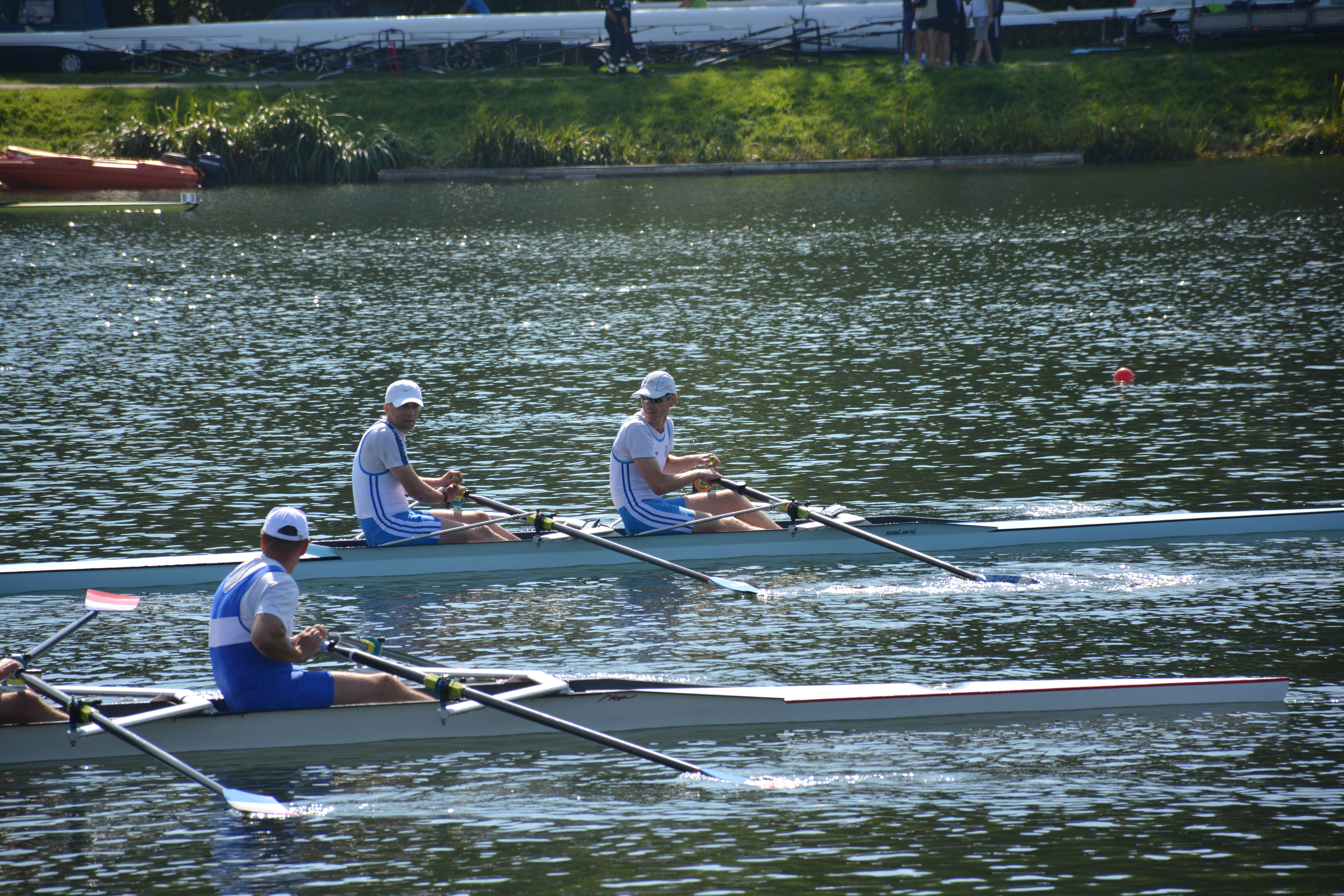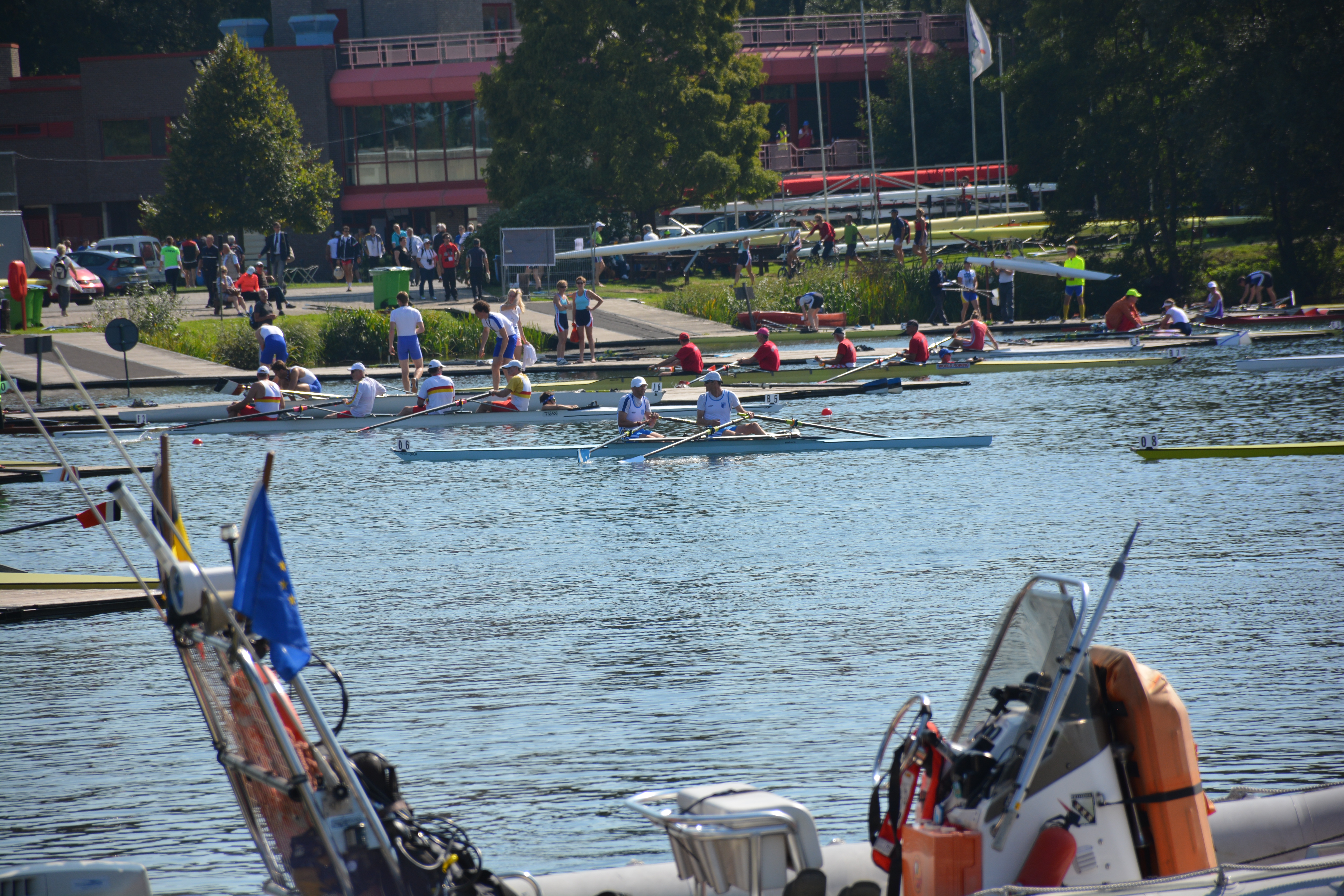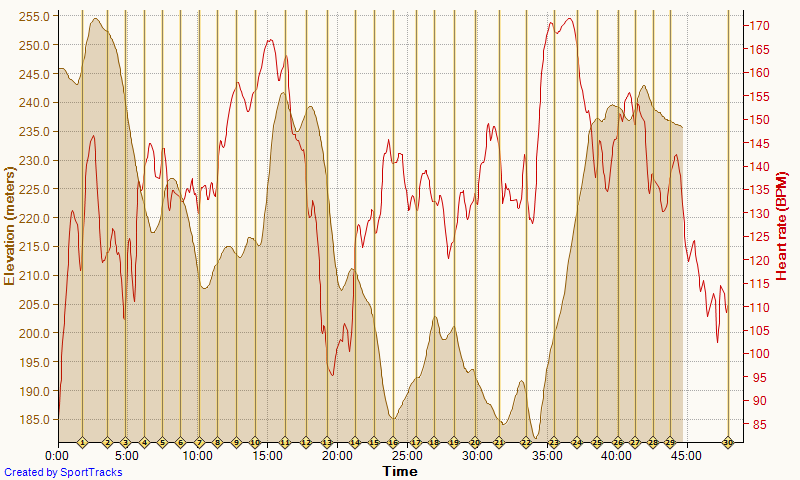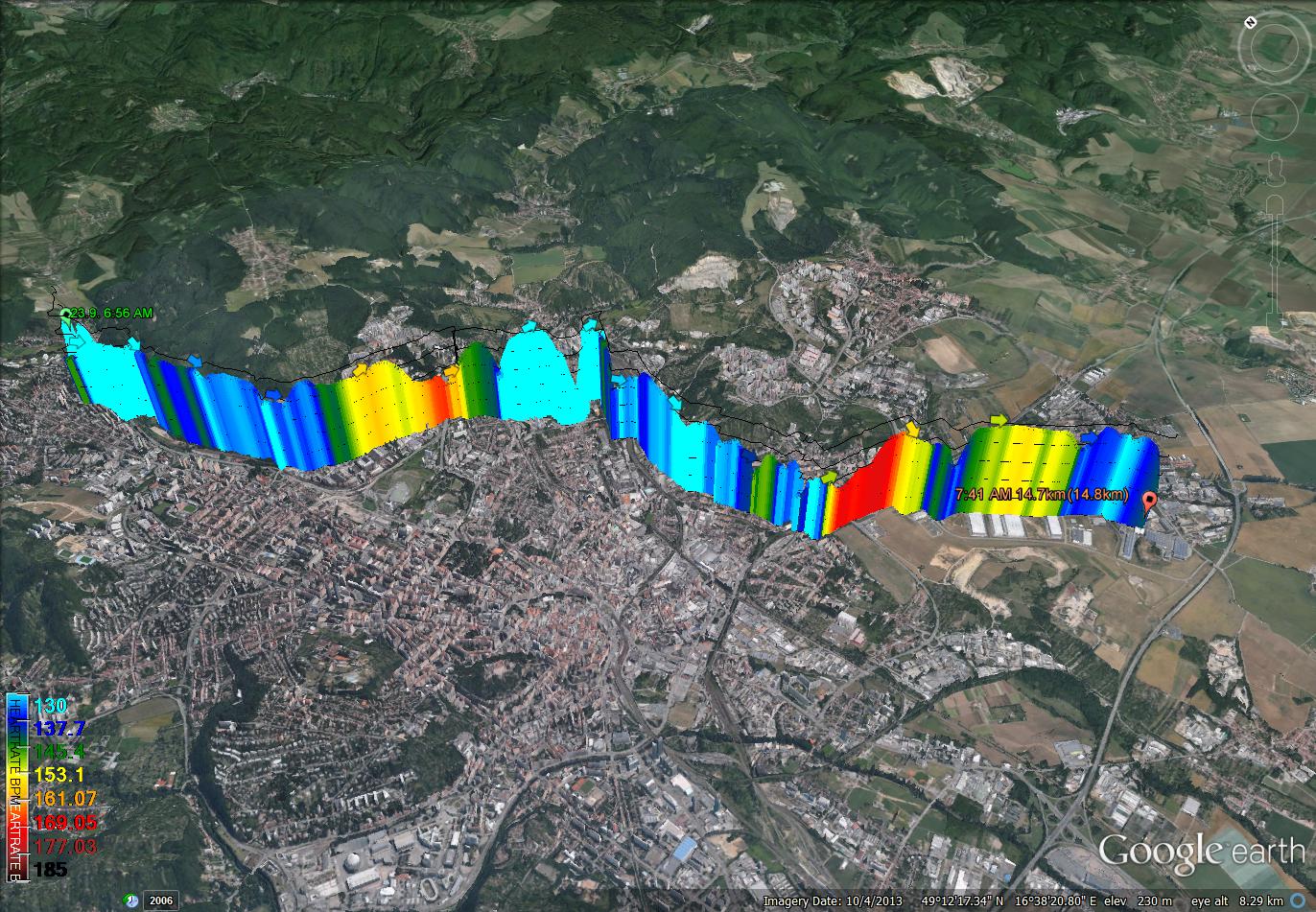Just before Hazewinkel …
Hey, I got a few new Hazewinkel pictures from Arjan today. Here they are:


The second picture nicely captures the organized chaos around the pontoons.
But where was I? Yes, just before Hazewinkel I bought this book, “Masterrudern: Das Training ab 40” by Volker Nolte and Wolfgang Fritsch. I have been reading it during my stay in Belgium and here is my review.
The back cover text promises to discuss the theoretical basis for training methodologies based on the most recent insights from the scientific literature, give concrete advice and tips for training for racing and fitness, as well as discuss learning to row at an older age, how to improve technique and how to rig the boat.
In my mind this is the first flaw of the book. It is trying too much at once. The first part basically just tells how great rowing is as a sport for “older” people. I guess most buyers of the book don’t need to be convinced about that. The second part, about learning to row at an older age, should in my mind have been a separate book. Now I feel I have paid for only one third of the book, the part about training for Masters rowers.
So the part that I am really interested in starts at page 137 and is roughly 100 pages long. After a brief introduction of how training works (the overcompensation effect) and the different training aims that Masters rowers may have (race performance vs just slowing down declining fitness with age), the authors introduce the following categorisation of different training forms:

The quick translations from German are mine, so don’t blame the authors for that. They then proceed to describe different training intensities and give rough OTW pace indications for the different intensities, based on either your steady state pace or your 1000m race pace. I believe a description of lactate or HR based determination of training intensities should have been appropriate here. Then the authors describe the rough proportions of the different training intensities in a balanced training program, as a function of age.
That’s where it become interesting. This is really the problem I am trying to find an optimized solution for:
Given my age, my time constraints, and my training goals, what is the optimum mix of boat training vs other types of training, and the different training intensities, for each part of the year?
I understand the authors cannot give a straight answer for a population ranging from 27 years to 90+, with training goals varying from “general fitness” to “winning the Masters Worlds” and training backgrounds varying from “couch potato” to “former OIympian”. I understand that. I want to closely read the book, collect the wisdom and then try to apply it to my own situation.
What made that a bit difficult to do is the sloppy writing style of the two authors (or the bad job done by the editor). They are switching back and forth between different names for the same (or roughly the same?) thing. For example the reader suddenly gets to read a text on threshold training, without finding threshold training as such in the breakdown of training forms (see above). It may be on purpose to stimulate a very close reading and good thinking by the reader, but I am more inclined to think that this is the result of two authors not fully coordinating their nomenclature. I believe that the text should have been written much more rigorously, with a very strict breakdown in categories. This would also make it much more easy to quickly look up a certain part, for example if you need inspiration for an “intensive endurance” boat training.
Regarding the recommendations for the different types of training (Compensation/Extensive Endurance/Intensive Endurance/Strength/Race specific), it would be interesting to see a discussion of the priorities and choices to make for athletes who have a limited time budget. The authors describe three (or perhaps more, it varies a bit from page to page) types of strength training, but how to build this into a program that has to limited to four days?
At the end, the authors do give an example of a typical week of training for exactly this case, a rower who has time for four sessions a week. Unfortunately, when I try to calculate the time spent in the different training zones/types, the result does not add up to the recommendation that I read 100 pages earlier. Are the authors contradicting themselves or did they implicitly make a prioritization based on the limited time?
Because, to be honest, if we want to follow exactly the recommendations, we either have to do 12 training units per week (which is perfectly fine for some, but not realistic in my case), or combine some things into one session. An alternative would be to smear out the distribution over several weeks, but no, the authors talk about two strength sessions per week, so that’s no alternative.
A hint is given in that famous 4 days per week training plan. For example, one Monday session consists of
- 30 min Strength 3 sets 5 repeats, 80% (1) clean (2) leg press (3) bench pull (4) bench press
- 30 minutes steady state OTW
Honestly, this is not practical in my case. Granted, our rowing club has quite a nice gym, but it takes me 25 minutes to drive there from work (and 15 from home), so when I do make the effort to go there, I want to spend more than 30 minutes on the water, especially when changing from indoor gym clothes to winter rowing, bringing in and out the boats, and other things add some overhead time to the entire duration.
On the positive side, the book has helped indeed in my thinking about my next training plan, but only after I made a powerpoint presentation to myself with all the collected wisdom from the book. I basically had to write an excerpt, reorganize the different topics, and do some interpretation before it became useful. As I enjoy playing with plans and schedules and the general engineering approach to problem solving, it was time well spent for me. But I am not sure this appeals to all rowers.
I will discuss my training plan for the coming winter in a next blog, coming soon, but one of the things I am thinking about is to increase the percentage of compensation, extensive endurance and pleasant cross-training in one sweep by introducing a bike commute a couple of times per week. I have recently bought a second-hand mountain-bike, which is a big enabler. My sturdy but heavy Dutch city bike was not the right thing for hilly Brno. Also, in the past year a number of new bike lanes have emerged around my route to work. My daily commute takes 20-30 minutes by car, 30-40 minutes by train and about 60 minutes by bus/tram. With the new bike, I can be under one hour including a shower at my destination, so this would be an effective way of introducing some more training kilometers in a time-effective way.
This morning I did a test ride.


I had forgotten how different a city commute between car exhausts is from a nice Sunday mountainbike ride through the forest, but looking at the heart rates this could qualify as a nice way of cross training.
In the afternoon I left the bike at work and returned by public transport. Tomorrow I will do the ride home, followed by an intensive erg training. That should really put this plan to the test.
I am still thinking about other ways to add a running training, two strength sessions, and divide the rest of the weekly sessions sensibly over the different training zones within the time that I have for sport (including driving to and from a rowing or fitness club), and I will keep you updated on my progress. Throw in a few business trips per month and you can see how everything I do is really a compromise.
The verdict: I don’t regret buying the book but I think a revised edition could be much better.
Follow me in social media
Like this:
Like Loading...
Sep 23 2015
Das Buch Review
Just before Hazewinkel …
Hey, I got a few new Hazewinkel pictures from Arjan today. Here they are:
The second picture nicely captures the organized chaos around the pontoons.
But where was I? Yes, just before Hazewinkel I bought this book, “Masterrudern: Das Training ab 40” by Volker Nolte and Wolfgang Fritsch. I have been reading it during my stay in Belgium and here is my review.
The back cover text promises to discuss the theoretical basis for training methodologies based on the most recent insights from the scientific literature, give concrete advice and tips for training for racing and fitness, as well as discuss learning to row at an older age, how to improve technique and how to rig the boat.
In my mind this is the first flaw of the book. It is trying too much at once. The first part basically just tells how great rowing is as a sport for “older” people. I guess most buyers of the book don’t need to be convinced about that. The second part, about learning to row at an older age, should in my mind have been a separate book. Now I feel I have paid for only one third of the book, the part about training for Masters rowers.
So the part that I am really interested in starts at page 137 and is roughly 100 pages long. After a brief introduction of how training works (the overcompensation effect) and the different training aims that Masters rowers may have (race performance vs just slowing down declining fitness with age), the authors introduce the following categorisation of different training forms:
The quick translations from German are mine, so don’t blame the authors for that. They then proceed to describe different training intensities and give rough OTW pace indications for the different intensities, based on either your steady state pace or your 1000m race pace. I believe a description of lactate or HR based determination of training intensities should have been appropriate here. Then the authors describe the rough proportions of the different training intensities in a balanced training program, as a function of age.
That’s where it become interesting. This is really the problem I am trying to find an optimized solution for:
Given my age, my time constraints, and my training goals, what is the optimum mix of boat training vs other types of training, and the different training intensities, for each part of the year?
I understand the authors cannot give a straight answer for a population ranging from 27 years to 90+, with training goals varying from “general fitness” to “winning the Masters Worlds” and training backgrounds varying from “couch potato” to “former OIympian”. I understand that. I want to closely read the book, collect the wisdom and then try to apply it to my own situation.
What made that a bit difficult to do is the sloppy writing style of the two authors (or the bad job done by the editor). They are switching back and forth between different names for the same (or roughly the same?) thing. For example the reader suddenly gets to read a text on threshold training, without finding threshold training as such in the breakdown of training forms (see above). It may be on purpose to stimulate a very close reading and good thinking by the reader, but I am more inclined to think that this is the result of two authors not fully coordinating their nomenclature. I believe that the text should have been written much more rigorously, with a very strict breakdown in categories. This would also make it much more easy to quickly look up a certain part, for example if you need inspiration for an “intensive endurance” boat training.
Regarding the recommendations for the different types of training (Compensation/Extensive Endurance/Intensive Endurance/Strength/Race specific), it would be interesting to see a discussion of the priorities and choices to make for athletes who have a limited time budget. The authors describe three (or perhaps more, it varies a bit from page to page) types of strength training, but how to build this into a program that has to limited to four days?
At the end, the authors do give an example of a typical week of training for exactly this case, a rower who has time for four sessions a week. Unfortunately, when I try to calculate the time spent in the different training zones/types, the result does not add up to the recommendation that I read 100 pages earlier. Are the authors contradicting themselves or did they implicitly make a prioritization based on the limited time?
Because, to be honest, if we want to follow exactly the recommendations, we either have to do 12 training units per week (which is perfectly fine for some, but not realistic in my case), or combine some things into one session. An alternative would be to smear out the distribution over several weeks, but no, the authors talk about two strength sessions per week, so that’s no alternative.
A hint is given in that famous 4 days per week training plan. For example, one Monday session consists of
Honestly, this is not practical in my case. Granted, our rowing club has quite a nice gym, but it takes me 25 minutes to drive there from work (and 15 from home), so when I do make the effort to go there, I want to spend more than 30 minutes on the water, especially when changing from indoor gym clothes to winter rowing, bringing in and out the boats, and other things add some overhead time to the entire duration.
On the positive side, the book has helped indeed in my thinking about my next training plan, but only after I made a powerpoint presentation to myself with all the collected wisdom from the book. I basically had to write an excerpt, reorganize the different topics, and do some interpretation before it became useful. As I enjoy playing with plans and schedules and the general engineering approach to problem solving, it was time well spent for me. But I am not sure this appeals to all rowers.
I will discuss my training plan for the coming winter in a next blog, coming soon, but one of the things I am thinking about is to increase the percentage of compensation, extensive endurance and pleasant cross-training in one sweep by introducing a bike commute a couple of times per week. I have recently bought a second-hand mountain-bike, which is a big enabler. My sturdy but heavy Dutch city bike was not the right thing for hilly Brno. Also, in the past year a number of new bike lanes have emerged around my route to work. My daily commute takes 20-30 minutes by car, 30-40 minutes by train and about 60 minutes by bus/tram. With the new bike, I can be under one hour including a shower at my destination, so this would be an effective way of introducing some more training kilometers in a time-effective way.
This morning I did a test ride.
I had forgotten how different a city commute between car exhausts is from a nice Sunday mountainbike ride through the forest, but looking at the heart rates this could qualify as a nice way of cross training.
In the afternoon I left the bike at work and returned by public transport. Tomorrow I will do the ride home, followed by an intensive erg training. That should really put this plan to the test.
I am still thinking about other ways to add a running training, two strength sessions, and divide the rest of the weekly sessions sensibly over the different training zones within the time that I have for sport (including driving to and from a rowing or fitness club), and I will keep you updated on my progress. Throw in a few business trips per month and you can see how everything I do is really a compromise.
The verdict: I don’t regret buying the book but I think a revised edition could be much better.
Follow me in social mediaShare this:
Like this:
By sanderroosendaal • Uncategorized • 2 • Tags: bike commute, book review, cross-training, OTW, rowing, training plan